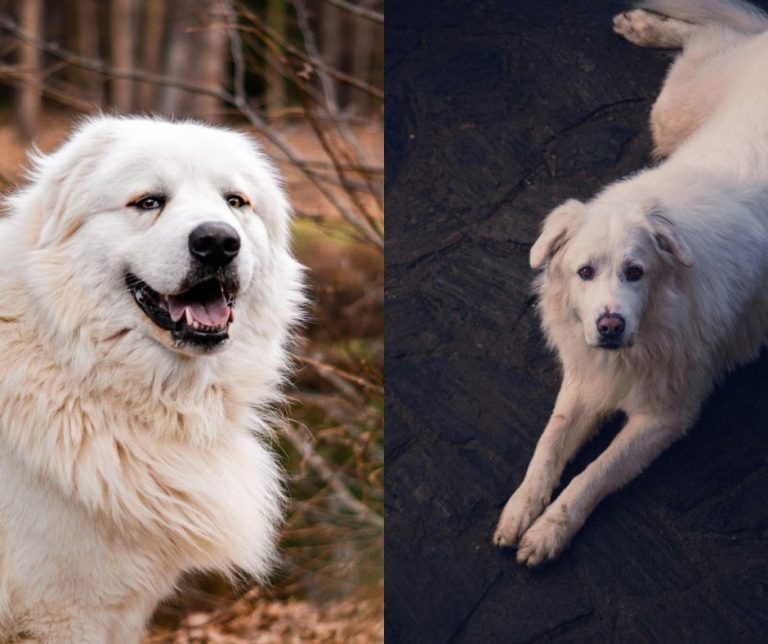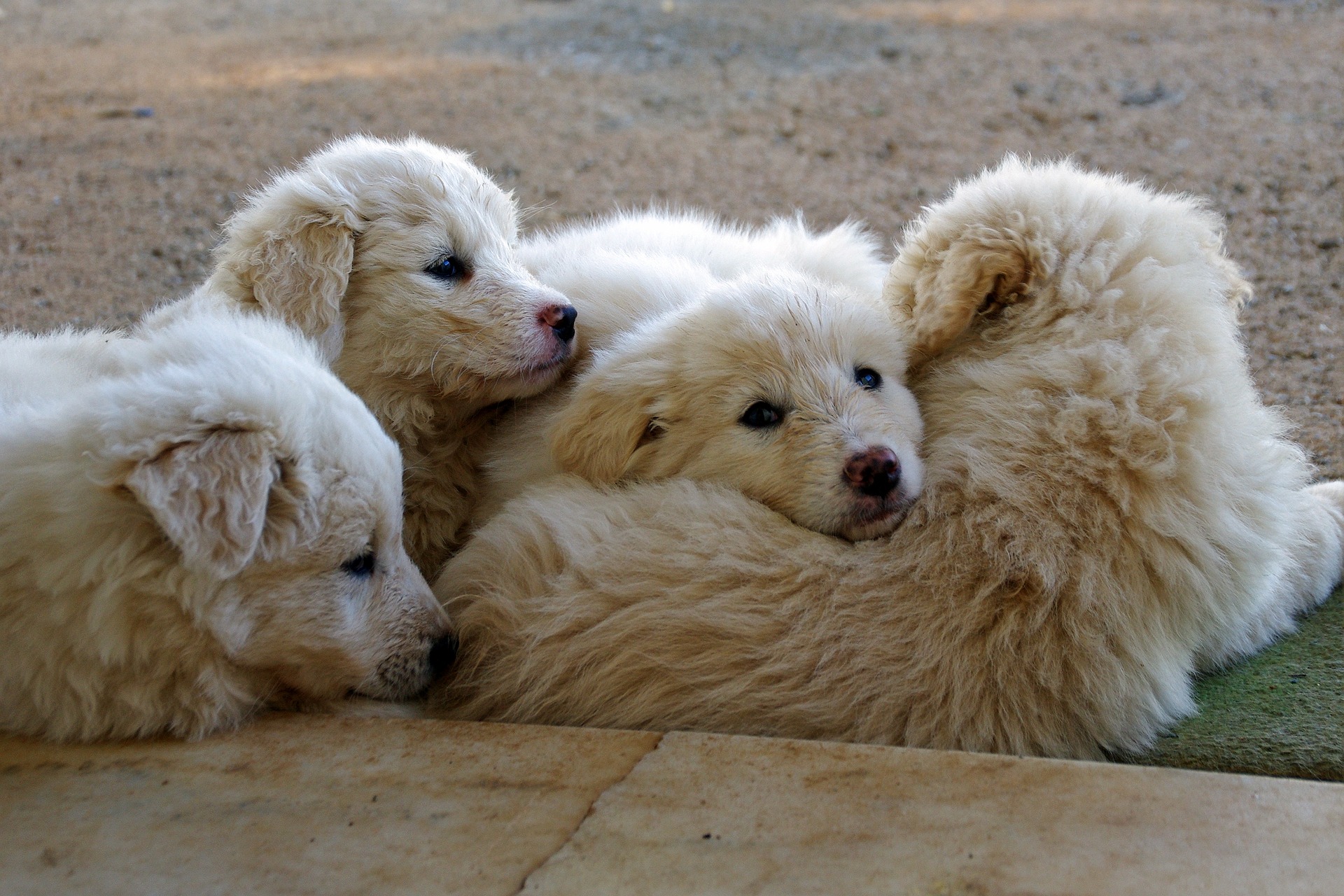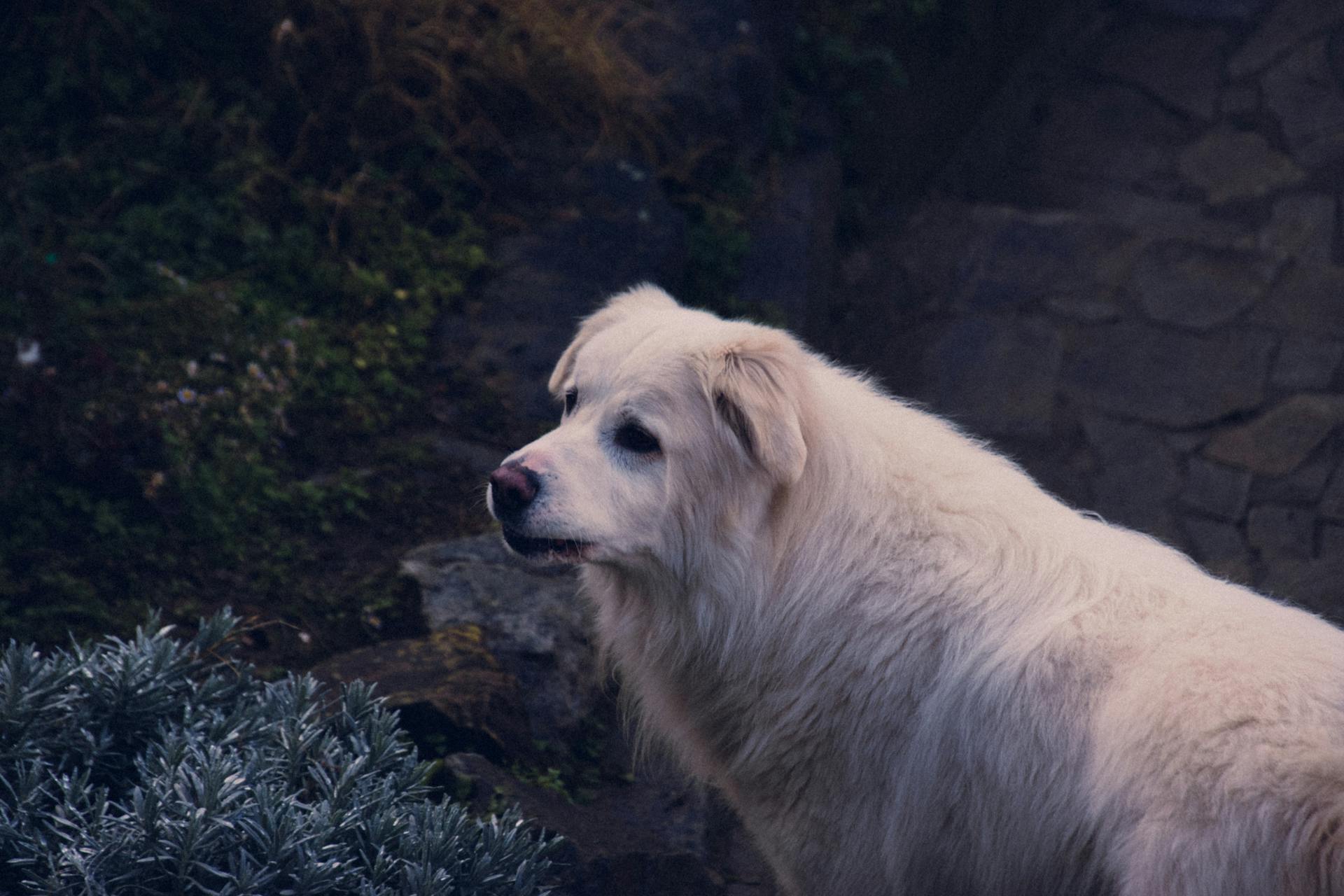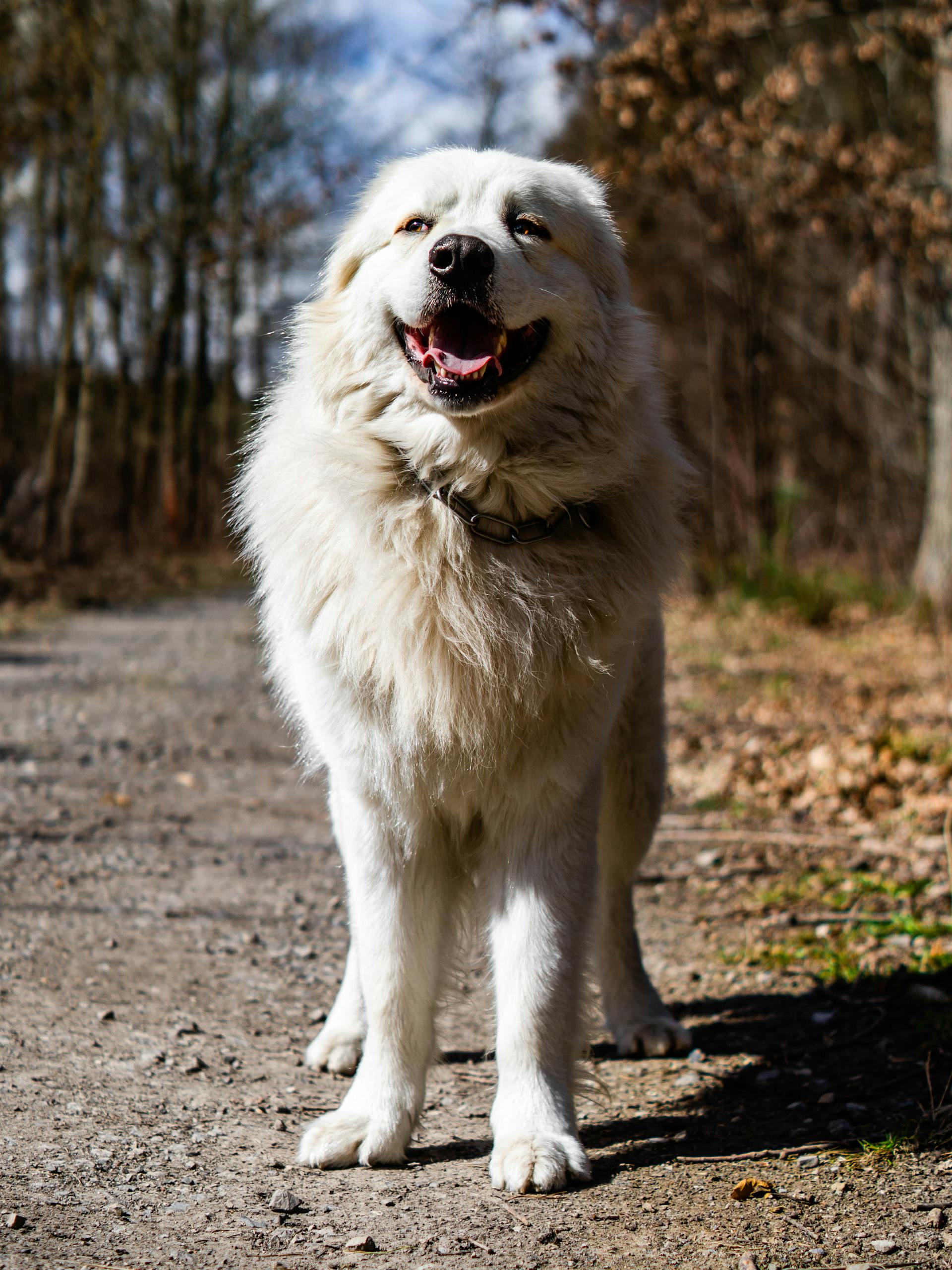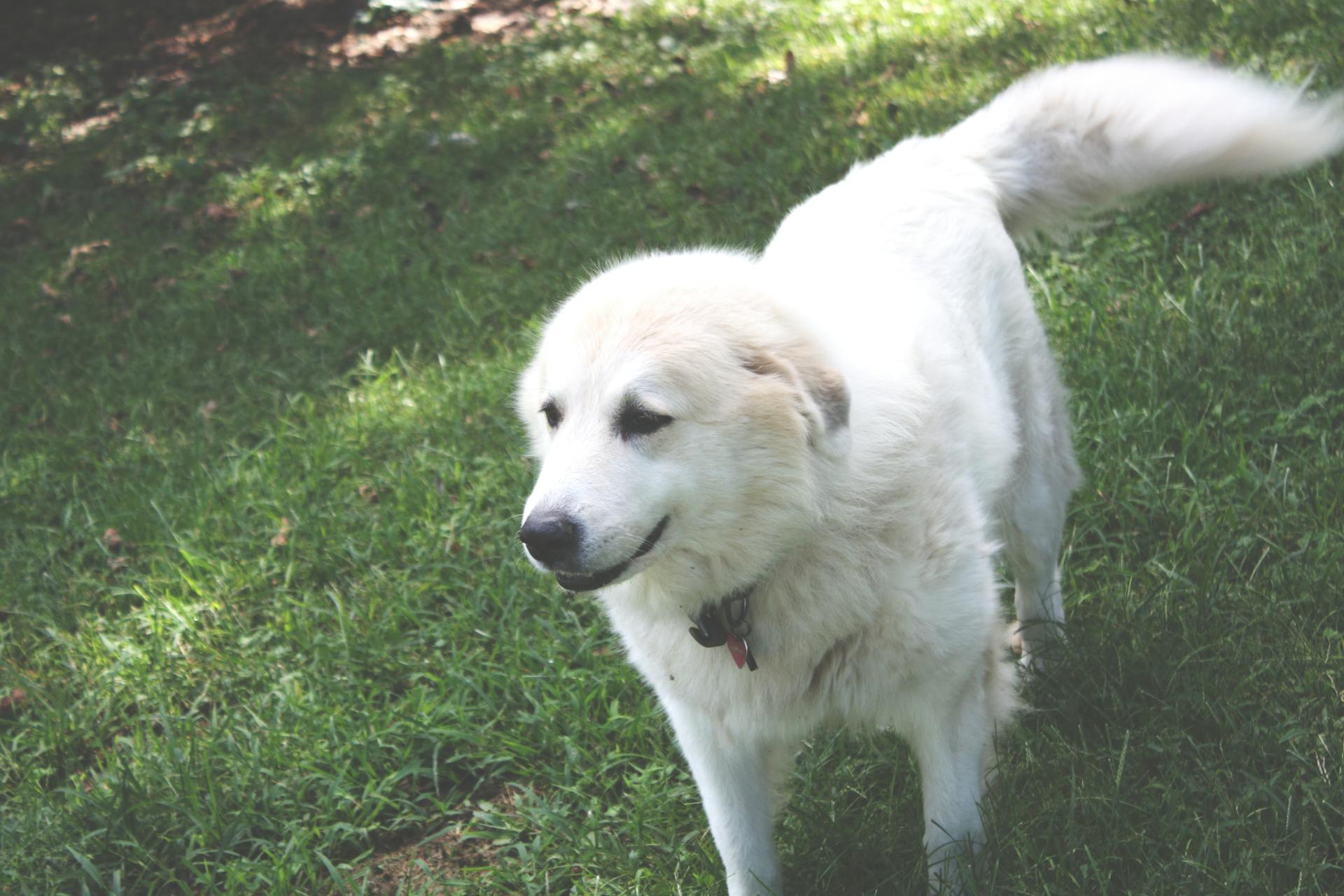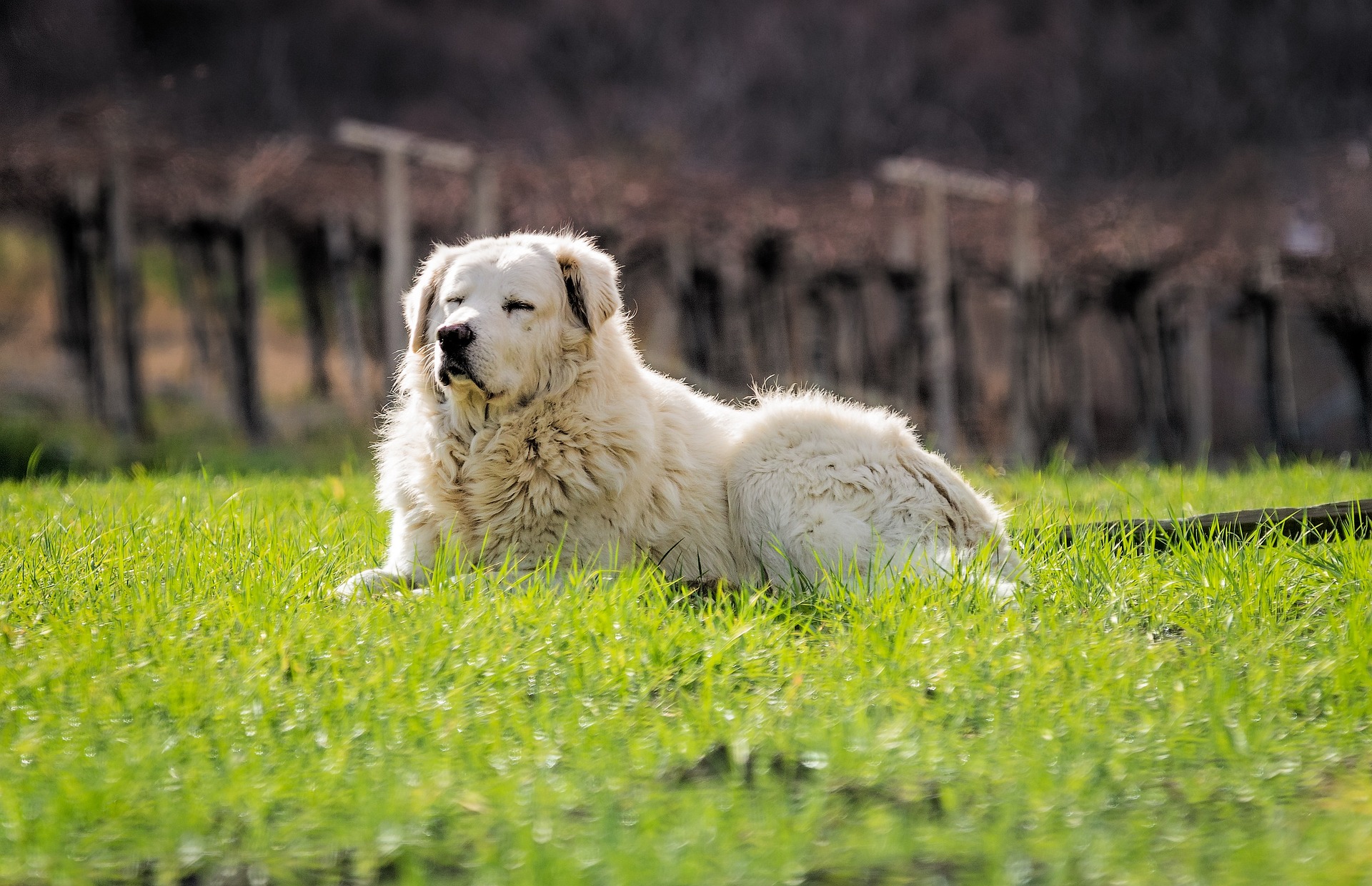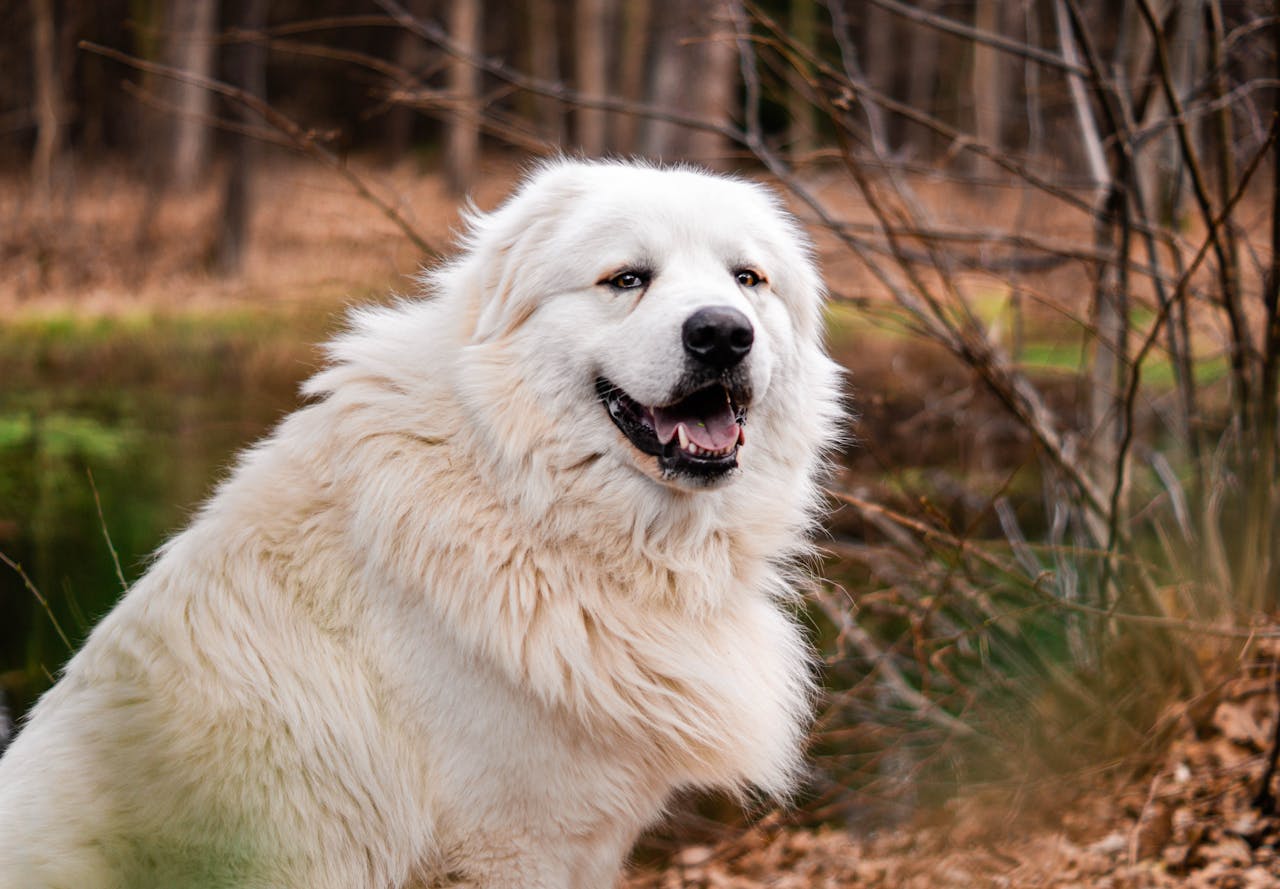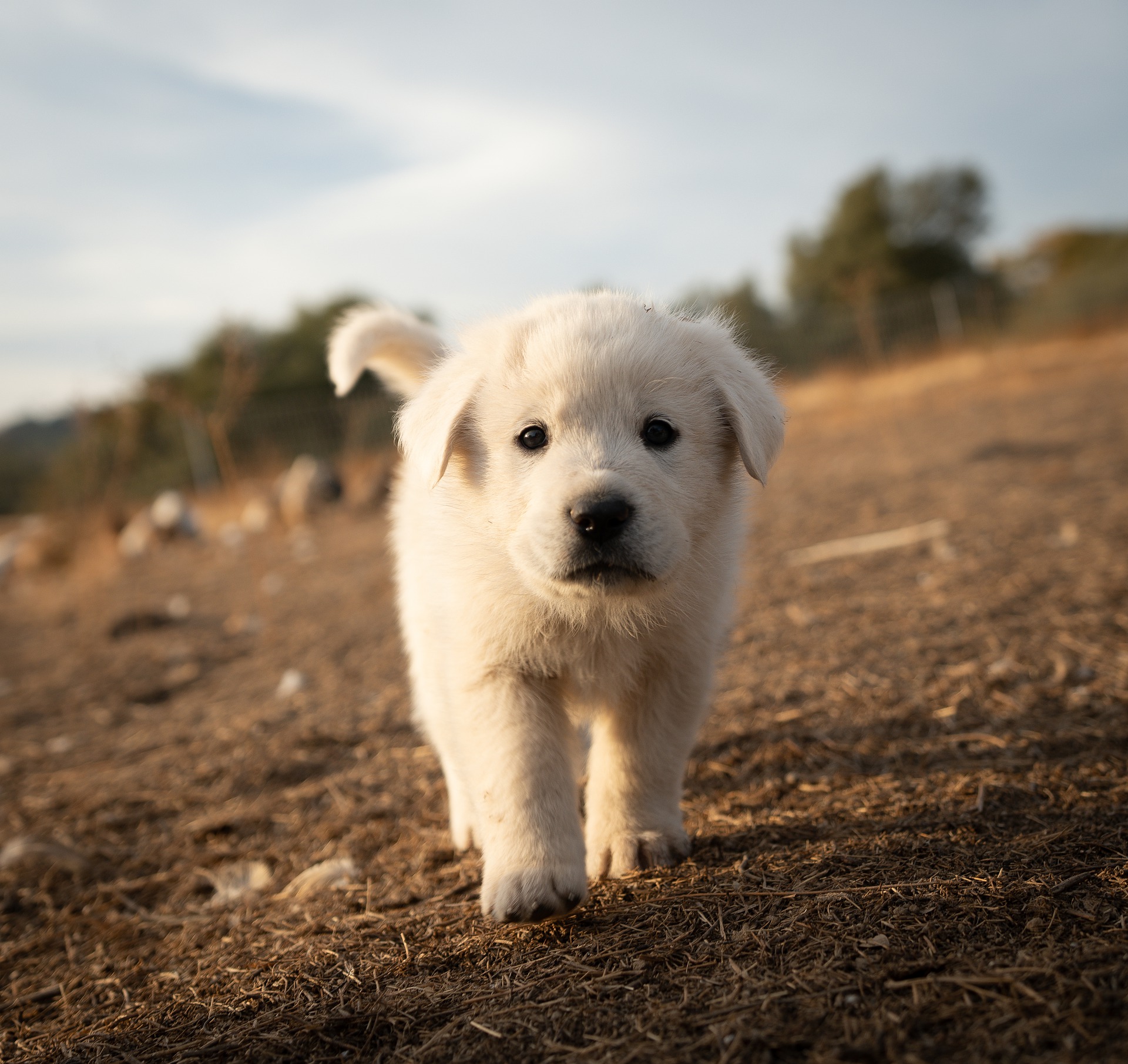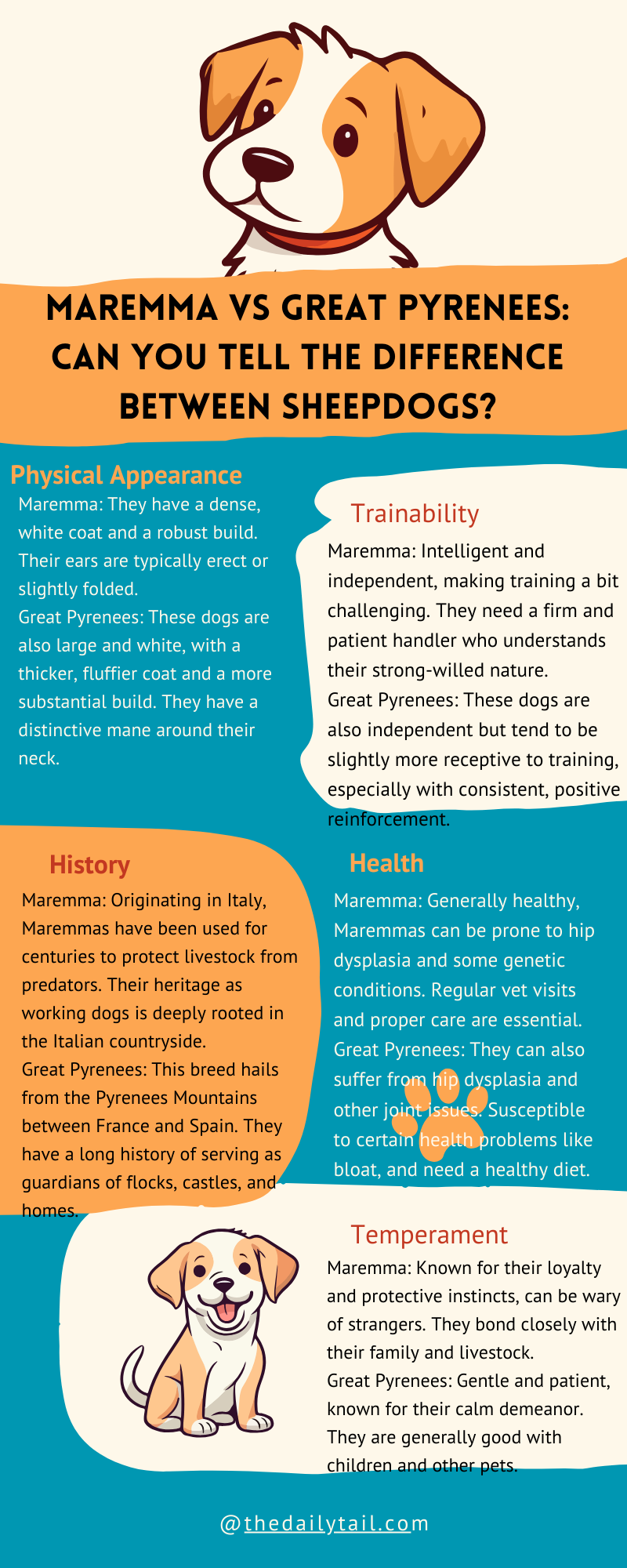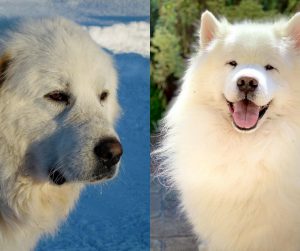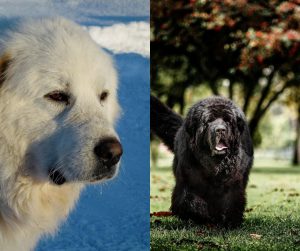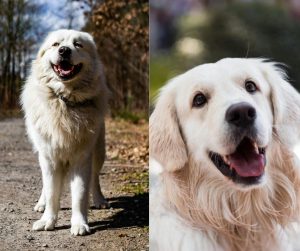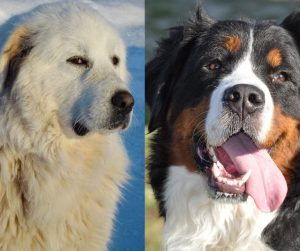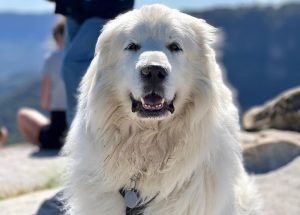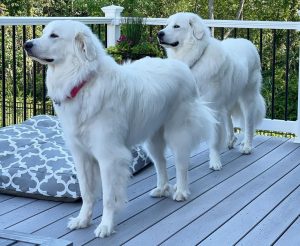Today, I want to talk about two rather unknown breeds. We cannot talk every day about the most popular dog breeds, right? Today, we will take a look at two amazingly beautiful sheep dogs.
I am sure not many of you have heard of the fluffy Maremma Sheepdog and the Great Pyr. Yes, I’ve written before about the Great Pyrenees dog breed. It is a beautiful farm dog that deserves more recognition.
Now, if you look at these two side-by-side, you might think there is no difference.
Yet, there is. Choosing between Maremma vs Great Pyrenees is often down to preferences. Each of these dogs has unique qualities that making a great sheep dog and farm dog.
One of the main difference between them is their origin. Maremma originates in Italy, while the Great Pyrenees descends from the mountainous region between France and Spain.
Both have impressive coats that do more than make them irresistible to cuddle—they also protect them from harsh weather.
But it’s not just about looks; their temperaments are what make them such cherished guard dogs. They’re usually calm yet assertive when needed and are pretty smart too!
You’ll find they can be a bit headstrong at times, so they’ll need a person who’s consistent in training and socialization. They’re like big-hearted gentle giants who take their job of protecting seriously but also enjoy being part of the family.
Key Takeaways
- Maremma Sheepdog and Great Pyrenees are prized for their guardian abilities with different origins, Italy and the Pyrenees mountains, respectively
- They boast protective coats and have personalities fit for both guarding and family life, requiring consistent training
- Both are large breeds with calm demeanors, but the Great Pyrenees tends to be a bit larger in size
Origins and History
As I said before, as a longtime dog owner, I am always fascinated by different histories of breeds. We cannot think that all dogs come from the US. Many of the popular dog breeds actually originated in Europe. So, let’s take a look at the different history of Maremma vs Great Pyrenees. These dogs have stood by shepherds for centuries, guardian giants between flocks and foes in Italy and France.
The Roots of the Maremma Sheepdog
The Maremma Sheepdog, often just called the Maremma, has its origins in Italy, tracing back to ancient shepherd dogs used in the region. This breed gets its name from the Maremma plains in Italy, where they’ve been working as sheep guardians for a very long time.
It’s said that these hard-working dogs have been around since as far back as 3000 BC. They’ve been protecting sheep from wolves and other predators, showing just how reliable and brave these dogs can be.
Living and working in Italy, these dogs have become pretty good at their job over the years.
The Great Pyrenees’ Past
Over in France, the Great Pyrenees’ history is just as impressive. Originating from the Pyrenees Mountains that form the natural border between France and Spain, these dogs are also known as the Pyrenean Mountain Dog.
They were bred to ward off predators like bears and wolves while watching over their flocks. Their history in Europe goes way back, too, and they were the chosen guardians for many a French noble’s estate.
Interestingly, the Great Pyrenees made their way to America in 1824, thanks to the Marquis de Lafayette, illustrating the breed’s spread and enduring appeal.
Physical Appearance
Comparing the Maremma and the Great Pyrenees is fascinating, especially when focusing on how they look. These dogs are stunning, each with their own unique style that makes them stand out.
Maremma’s Looks
Maremmas have a strong presence with their sturdy build. They typically weigh between 70-100 pounds and their height ranges from 23-28 inches.
Their coat is a sight to behold—elegantly thick and usually white, though you might spot shades of tan or gray that give them a distinctive appearance.
This double coat isn’t just for looks; it serves as a protective layer too, especially important for a breed known to watch over livestock.
The Majestic Appearance of the Great Pyrenees
When someone talks about the Great Pyrenees, the first thing you probably picture is their impressive size. Full-grown males can stand 27 to 32 inches at the shoulder and females 25 to 29 inches, with males often reaching up to 100 pounds or more, while females tip the scales at around 85 to 115 pounds on average.
They have a thick white coat which can sometimes feature a splash of tan or gray.
It’s not just a single layer, but a lush double coat that helps these gentle giants stay warm in cold weather. They even have a fuller mane around the neck, making them look quite regal.
Personality and Temperament
Comparing the Maremma and the Great Pyrenees, we find some key differences in their nature. Both breeds are smart and like to think for themselves, but how they interact with people and other animals varies.
Maremma’s Character
The Maremma sports a personality of independence and a watchful eye. Typically a bit on the reserved side, Maremmas take their job as a guardian seriously.
They’re not the type to run up and lick a stranger’s face. Instead, they prefer to size up newcomers from a distance before deciding if they’re friend or foe.
This careful way of dealing with new people means they’re stellar at watching over livestock or keeping an eye on the family home. But don’t let their serious nature fool you; give a Maremma some time to warm up, and you’ll have a loyal friend for life.
Great Pyrenees’ Nature
Now, the Great Pyrenees is like that friend who’s always cheerful and ready to meet new people. They’ve got a friendliness about them that’s hard not to love.
Especially patient and gentle, these big dogs make great pets for families. They’re the sort of pooch that’ll hang out happily with kids and adults alike, always up for a good petting session or a leisurely walk around the block.
But don’t forget, despite their sociable nature, the Great Pyrenees still takes their job as a protector to heart. They’ll stand guard and keep a watchful eye on their family with all the dedication you’d expect from a top-notch guardian breed.
Training and Socialization
When it comes to training and lovingly guiding these big-hearted breeds, patience and positivity are your best tools. These dogs are smart, but they might show a stubborn streak, so consistent and kind training from puppyhood is key to a well-mannered adult dog.
Educating Your Maremma
Training a Maremma Sheepdog—an independent thinker—favors a touch of creativity. He isn’t the type to do something just because you said so; he needs to see a reason.
Starting early is the secret. As puppies, Maremmas are more receptive to learning, and this is when you should introduce them to lots of new faces and places.
Praise them when they get it right, and be gentle when they don’t.
Use positive reinforcement: treats, toys, and pats on the head can work wonders for their motivation.
But remember, Maremmas might not always want to play the game, especially if they’re bored—keep sessions short and fun.
They’re a tad more serious-minded, so they may prefer a job-like task over a simple trick.
- Training Techniques
- Keep training sessions short and sweet
- Use treats and toys as rewards
- Introduce new experiences early on
- Avoid harsh corrections; be firm but fair
- Socialization Goals
- Expose them to different people, animals, and environments
- Encourage calm and respectful interactions
- Reinforce good behavior with praise and rewards
Guiding the Great Pyrenees
Though equally big and fluffy, the Great Pyrenees shines with a more affectionate character, always eager to please those he loves. This makes training a bit different.
He’s still smart and might have a stubborn moment or two, but he responds really well to a gentle hand and kind words.
He’s a social butterfly compared to the Maremma and will enjoy being around you and others more.
Use positive reinforcement here too, but feel free to mix it up with games and social activities as part of the training—this helps them link learning to good times with friends, both two-legged and four-legged.
- Training Pointers
- Use a gentle, patient approach
- Mix training with play and social activities
- Keep praising good behavior often
- Socializing Steps
- Create opportunities for interaction with other pets and people
- Teach him to be gentle and calm, even with excitement
- Reward him for good behavior in social settings
Exercise Needs
Whether they’re romping in a spacious backyard or taking a leisurely walk, both the Maremma and the Great Pyrenees have specific exercise needs to stay happy and healthy. Let’s take a look at what keeps each breed ticking.
Keeping Your Maremma Active
Maremmas are the more energetic of the two breeds, with a tank full of energy to burn. They’re not your typical lounge-around-the-house kind of dog.
They thrive on having a job to do or space to patrol. Daily exercise is critical for these pooches; think a good, long walk or a play session in a securely fenced area where they can stretch their legs out.
Without enough activity, Maremmas might find their own ‘jobs’—and that could mean landscaping your garden in ways you didn’t intend!
Exercise is not just good for their physical health but also keeps their smart minds engaged.
If you’re an apartment dweller, keep in mind that Maremmas prefer more room to roam and might not find the confined space to their liking. They definitely do best with more space where they can be active and vigilant.
Great Pyrenees’ Activity Requirements
The Great Pyrenees might appear like gentle giants who are content to just hang out, but don’t let that fool you—they still need their daily dose of exercise.
They might not need as much as a Maremma but skipping out on their activity can lead to bored and unhappy pups.
They’re generally cool with a moderate walk each day; some might even be up for a longer stroll if you’re game.
The thing is, they have to move those big fluffy bodies to keep fit and prevent becoming couch potatoes.
For folks living in apartments, a Great Pyrenees can adapt, provided they get out regularly for their exercise fix.
These dogs do enjoy a bit of lounging, but ample exercise is key to maintaining their well-being.
Remember to give your Great Pyrenees time for a leisurely sniff-and-stroll to keep that tail wagging.
Health and Care
The health and care of Maremma Sheepdogs and Great Pyrenees involve attention to common breed-specific health issues and grooming needs.
Owners must be attentive to their dog’s overall well-being and routine maintenance to ensure a happy and healthy life for their furry companions.
The Well-being of Maremmas
Maremma Sheepdogs, with their fluffy coats and strong builds, are typically healthy with a lifespan ranging from 12 to 15 years.
Keeping these dogs in tip-top shape involves regular check-ups and watching out for a few key health concerns.
Hip dysplasia, a condition where the hip joint doesn’t fit together perfectly, can be a concern in larger breeds like Maremmas.
You should have your vet check for this, especially as your dog ages.
Elbow dysplasia is similar, but it affects the elbows and can also cause discomfort or limited mobility.
Keeping an eye on any signs of obesity is also crucial.
With a proper diet and exercise, you can keep weight-related issues at bay.
Maremmas’ thick white coats mean shedding is a given.
Regular grooming to remove loose hair and prevent mats is not only good for their look but for their comfort as well.
And while we’re speaking of comfort, eye problems can be a thorn in their side, so regular vet check-ups can help catch any issues early on.
Caring for Your Great Pyrenees
Great Pyrenees are gentle giants known for their calm demeanor and patience.
Their lifespan is slightly shorter, usually 10-12 years, but with good care, they can live full, happy lives.
Just like their Maremma cousins, hip dysplasia is a common condition due to their size, so keep a close watch on your dog’s mobility and pain levels.
Bloat is another big concern.
This scary condition happens when their stomach fills with gas and can twist, cutting off blood flow.
To help prevent it, give them smaller meals throughout the day rather than one big one.
Grooming is pretty important for these fluffy dogs. They have a double coat that protects them from the elements but also sheds quite a bit, especially during seasonal changes.
Regular brushing, say once a week, can help keep their coats healthy and your home less hairy!
While you’re at it, keep an eye on their eyes! Like Maremmas, they can have issues, and catching things early makes a big difference.
Role as Guardian Dogs
The Maremma and the Great Pyrenees have been trusted as guardian dogs for centuries. These dogs shine when it comes to protecting livestock from various predators, emphasizing their role in maintaining the safety and well-being of flocks.
Maremma in Protection
Maremmas are vigilant guardians that take their job very seriously.
You’ll often find them blending in with the sheep, always watchful and ready to act against any threat.
They have a strong instinct to protect their flock, and they do it with a solid presence and confidence.
Shepherds value Maremmas for their independence and tendency to think for themselves, making them reliable even when they’re out of sight among the herd.
The Great Pyrenees as Protectors
On the other hand, the Great Pyrenees are known for their commanding size and calming nature.
Despite being large, they’re gentle with their flocks but intimidating to would-be predators.
It’s their impressive size and fearless heart that help them guard their charges effectively.
Even in the dead of night, these dogs are on patrol, ensuring everyone is safe until the morning’s light.
A Great Pyrenees doesn’t shy away from a challenge, standing their ground with a boldness that sends a clear message: not on their watch.
Choosing the Right Dog for You
When folks are looking to add a furry member to their family, picking the right breed is key.
They often wonder about the differences between breeds, especially when they look so similar and have job-specific skills like the Maremma and Great Pyrenees.
It really boils down to the family’s lifestyle, their home, and what they expect from their dog.
Is a Maremma Right for Your Home?
Imagine a dog with a watchful eye over the hills, agile and sturdy—this is the Maremma for you.
Ideal for active families who might live in more hilly or rugged terrain, this breed is a bit smaller than the Great Pyrenees, making them more agile, yet they still offer solid protection.
They’re loyal and affectionate companions that take their job as guard dogs to heart, especially where livestock’s involved.
Pros:
- Protective: They’ve got your back when it comes to guarding your home
- Adaptable: They do well in various settings, though they love space to roam
- Affectionate with Families: They create strong bonds with their humans, making them good family pets
Considerations:
- Barking: They tend to make noise to alert you, which could be an issue in noise-sensitive areas
- Space Needs: They thrive in homes with lots of outdoor space
- Other Animals: Early socialization is important if living with other pets
Would a Great Pyrenees Suit Your Family?
The Great Pyrenees dog is like a gentle giant—their size doesn’t hinder their kind nature. They’re great for families looking for a calm but effective protector.
This breed prefers flatter, open spaces. They make a superb guardian with a naturally protective instinct towards their family and flock.
Pros:
- Temperament: Calm and patient, great around children and as a family companion
- Trainability: With consistency, they can be well-trained, though they have a strong-minded nature
- Protector: A dependable guardian, they’ll stand guard without a second thought
Considerations:
- Shedding and Grooming: They have thick coats that need regular maintenance
- Exercise Needs: Suitable for families that can provide moderate exercise
- Independence: They have a more independent streak, which can challenge first-time dog owners
Choosing between a Maremma and a Great Pyrenees isn’t about which dog is better overall. It’s about which dog is better for you and your setup.
They both bring joy and protection to a home, but their needs and personalities might match up differently with what you’re looking for.

